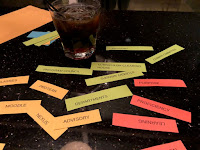Guest Post: Written by 10th grade student Sabine Foerg
There are so many factors in life that tell us we can't do things.
From a young age, it is the societal norm to teach kids not to take risks. Don't jump off the swing set. You aren't tall enough to go on the slide. Don't talk to strangers, don't cross the street alone.
This is protection, the teaching of survival. At some point in every child's life, they need to take risks, for risks are what define who they are. I am not referring to risks like jumping off the swing set (although some kids just have to learn that one the hard way) . I am referring to larger, scarier risks, where the jump feels much further than the drop from a swing. They start small, with the raise of one's hand in class when they aren't sure of the answer. The risk of the unknown, the risk of being judged. Soon those risks turn to standing up for oneself, one's beliefs, or a peer: the risk of speaking one's mind, no matter the cost.
There are people in this world who tell youth that we can't do things. We are too busy being on our phones, we don't care about the world around us, we don't know how to interact. They say we have lost the ability to think for ourselves for the sake of the comfort of avoiding risks. This unfair stereotype brings us down as we are told we are stupid. It brings us down as we are told our ideas are invalid. In my own school, I have been told that my generation's collective mind is hollowed out with our lack of ideas. I have been told that we need information spoon fed to us like we are small children in need of constant care. As this opinion of my incompetence was drilled into my brain, a constant stream of busywork and worksheets piles onto my desk. My hand cramps at the end of a long classes of notes, and my brain is filled to maximum capacity with facts and dates and formulas.
Contradiction? I think yes.
When the worksheets are shoved aside and conversation is finally allowed, conversations filled with ideas and opinions begin. My generation marched for our rights and our beliefs. We have raised thousands upon thousands of dollars for causes we deem important. We debate current issues and share solutions with one another. We talk to and write to and email our representatives and government. We take risks because of who we are, not because our textbooks taught us to. Those risks can and have changed the world.
So, no, maybe I don't have an opinion on the effects of an obscure war that happened hundreds of years ago and has since been forgotten. I don't care about the chemical makeup of the stalk of a plant, but this does not make me or my generation mindless. We want to know how to make the world a peaceful place now. We want to help solve global warming, we want our opinions valued. The things that we care about don't come from a textbook. We are not shallow, and we do take risks. We can prove society's opinion of us wrong over and over again, and we will continue to prove them wrong for the rest of our lives. Our current education system only prevents us from taking these risks. We should be learning about how TO change the world, not only about how it has changed in the past. We should be out in the world sharing our ideas and opinions, because they ARE valid. Education is stuck in a parked car on the highway while the rest of the world speeds past us. All they have to do is give us the keys.


